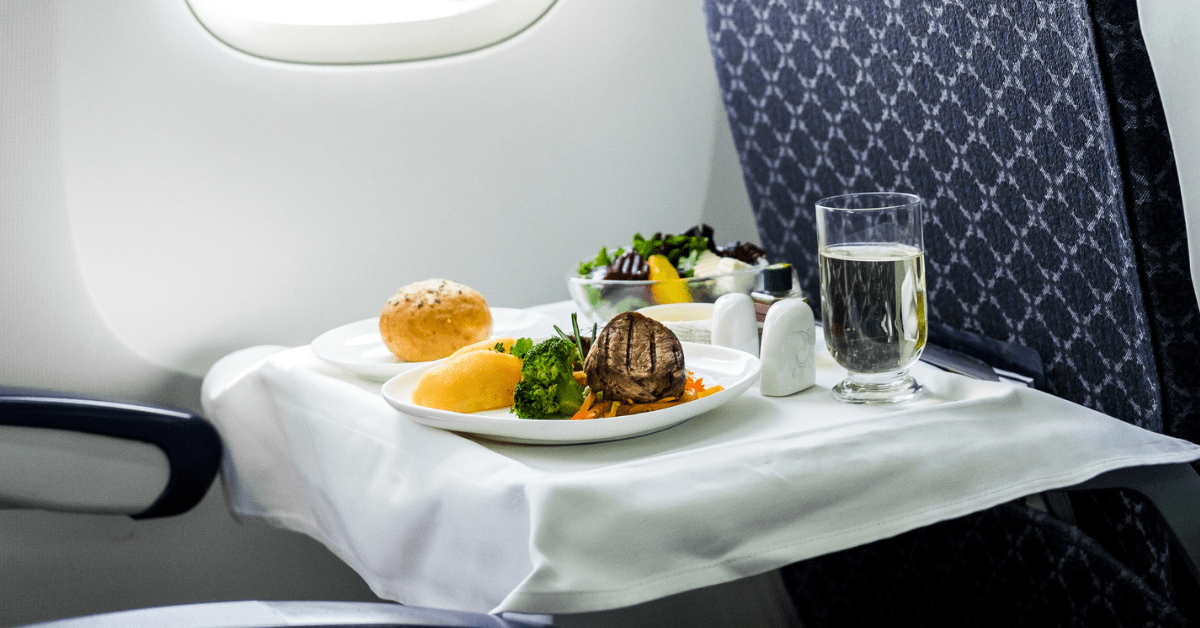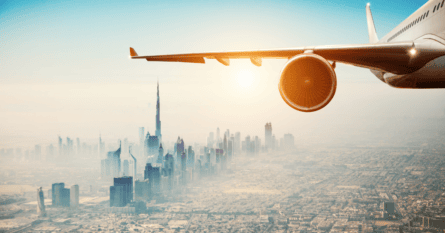We talked to airline food reviewer Nik Loukas about the current state of sky-high cuisine.

Airline food can be hit-and-miss, and airline cuisine reviewer Nik Loukas knows this better than anyone. He’s worked in the airline and travel industry for 15 years and runs Inflight Feed, which reviews and ranks the food served by airlines from around the world.
Loukas, who has been behind the scenes at many airport caterer kitchens to explore exactly how airline meals are made, said many aren’t aware of the thought and planning that goes into developing and creating delicious airline fare.
“They [the passengers] only see the end result which is a hot meal served at high altitude whilst traveling at over 800 km an hour,” he said.
“What they don’t see is the months of planning and preparation by airline caterers to get that meal to them inflight.”
Over the past seven years, Loukas has flown and dined on more than 500 flights. If you’re looking for an expert’s advice on which dish to choose, Loukas suggests curry as a safe and reliable option, while seafood is the hardest for airlines to get right.
“Curry always works well, and for some reason, the taste is enhanced at high altitude. So if there is ever a curry onboard, go for it.” He said.
Loukas loves flying with both Singapore and Thai Airways, as he said they both serve consistently flavorful and creative dishes, however his best airline meal to date was a pre-order upgrade with Austrian Airlines. The meal was a Japanese-style bento box, with edamame, sushi, wild salmon avocado tartar, duck breast Masao, Sakura salad, and chocolate mousse, for which he paid just €15 ($17 USD) extra.
“I paid a fee to get a better meal, and it was probably better than any first/business-class dish I have had,” he said.
Where do airline meals come from?
Airline meals are designed in collaboration with professional chefs, with some airlines even employing celebrity-level restaurateurs for a little extra star power. Singapore Airlines recently announced a collaboration with celebrated German chef Johan Laffer, while those flying first-class with Air France can be treated to meals designed by no less than three famous French chefs – Anne-Sophie Pic, Régis Marcon, and Guy Martin. The process of designing, testing, and perfecting a new menu can take months before its ready to launch.
While chefs may spearhead the design of these meals, it’s often the job of large airport-adjacent caterers to actually cook and assemble them.
This video by airFlyGo shows the process of making Emirates Airlines’ meals from scratch. The process is highly automated and runs day and night to keep up with demand. Airline food is often prepared in advance on the ground, chilled, and then loaded into the aircraft where it is reheated and served on board.
Cooking for the 400-600 person capacity of a Boeing 747 while 30,000 feet in the air would be a logistical nightmare and for safety reasons, airplanes can’t have stovetops or extensive kitchens. You can, however, be sure that your meal is safe to eat. The preparation of airline food is regulated by the International Flight Services Association, with strict rules regarding temperature control, storage, cooking, assembly, and dispatch.
High-altitude culinary tricks
When it comes to dining environments, being crammed into a seat surrounded by hundreds of other people at high altitude isn’t at the top on anyone’s list.
Ambience aside, the low humidity, high-pressure environments found in aircraft cabins can reduce our ability to taste food properly, meaning even a fiery tikka masala may taste bland onboard. Food scientist Charles Spence published a book in 2017, which discusses how noise levels can actually interfere with our ability to taste. Spence noted eating is a far more multi-sensory experience than we realize, and the 80-85 decibels of background noise we experience during air travel can imbalance our senses, throwing our taste buds off-kilter.
According to Spence, the only flavor that is actually enhanced at altitude is the savory umami, often found in Japanese cooking. A number of airlines report the most commonly consumed cocktail on board is the Bloody Mary, which is said to incorporate umami flavors.
Airlines are acutely aware of this and have developed ways of making sure their meals taste delicious in the air. In-flight meals commonly contain more spice, salt, and sugar than would traditionally be used on land, and airlines will often choose more robust and flavorsome dishes when designing airline menus.
Singapore Airlines have taken things to the next level. According to their website, they sample all their chef’s creations in simulated cabins, adjusting the flavors to make sure the dishes will work at high altitude.
Cathay Pacific is also coming up with creative ways to improve the gastronomical experience of their customers, brewing craft beer with the specific ingredients, aroma, and level of carbonation required to taste excellent in the air.
Higher quality and more variety – at a price
Unlike the golden years of travel where fares were all-inclusive, airline food today often carries a price tag. Many airlines offer the option of upgrading standard meals to more deluxe or specialty options for an added fee. Those flying Air France can upgrade to various a la carte options including a health-conscious grilled chicken and quinoa salad, while British Airways offers classic pub grub upgrades with their “taste of Britain” and “great British breakfast” menus.
While paying extra for the basic necessities of life is a drag, airlines are working harder to improve the quality of their meals in a bid to sell more. Some airlines are so confident in their revamped menus, they’re willing to take a gamble by serving them on land.
The CEO of low-cost carrier AirAsia recently announced plans to open a restaurant serving their range of regional Malaysian dishes, while Air New Zealand showed similar confidence back in 2017 when they launched a pop-up restaurant in London to market their latest menu, complete with airline seats and tray tables.
Best airline food in the business
So which airlines are going to blow you away with their gastronomical offerings this year?
According to InflightFeed, Thai Airways has the best economy airline meals, with a range of delicious Thai dishes as well as a number of international options. Coming in second place for economy-class is Turkish Airways with their tasty veggie and rice-packed Mediterranean dishes.
Those flying business-class or first-class are spoiled for choice. Japanese-owned ANA’s business-class meals have received multiple mentions from travel bloggers for their offerings, while Air France’s gourmet first-class meals are perhaps the most decadent.



